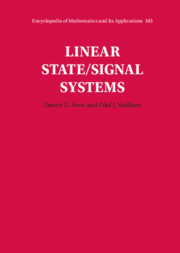Book contents
- Frontmatter
- Contents
- Preface
- Notations
- 1 Introduction and Overview
- 2 State/Signal Systems: Trajectories, Transformations, and Interconnections
- 3 State/Signal Systems: Dynamic and Frequency Domain Properties
- 4 Input/State/Output Representations
- 5 Input/State/Output Systems: Dynamic and Frequency Domain Properties
- 6 Bounded Input/State/Output Systems in Continuous and Discrete Time
- 7 Bounded Input/State/Output Systems in Continuous and Discrete Time
- 8 Semi-bounded Input/State/Output Systems
- 9 Semi-bounded State/Signal Systems
- 10 Resolvable Input/State/Output and State/Signal Nodes
- 11 Frequency Domain Input/State/Output Systems
- 12 Frequency Domain State/Signal Systems
- 13 Internally Well-Posed Systems
- 14 Well-Posed Input/State/Output Systems
- 15 Well-Posed State/Signal Systems
- Appendix A Operators and Analytic Vector Bundles in H-Spaces
- References
- Index
15 - Well-Posed State/Signal Systems
Published online by Cambridge University Press: 05 May 2022
- Frontmatter
- Contents
- Preface
- Notations
- 1 Introduction and Overview
- 2 State/Signal Systems: Trajectories, Transformations, and Interconnections
- 3 State/Signal Systems: Dynamic and Frequency Domain Properties
- 4 Input/State/Output Representations
- 5 Input/State/Output Systems: Dynamic and Frequency Domain Properties
- 6 Bounded Input/State/Output Systems in Continuous and Discrete Time
- 7 Bounded Input/State/Output Systems in Continuous and Discrete Time
- 8 Semi-bounded Input/State/Output Systems
- 9 Semi-bounded State/Signal Systems
- 10 Resolvable Input/State/Output and State/Signal Nodes
- 11 Frequency Domain Input/State/Output Systems
- 12 Frequency Domain State/Signal Systems
- 13 Internally Well-Posed Systems
- 14 Well-Posed Input/State/Output Systems
- 15 Well-Posed State/Signal Systems
- Appendix A Operators and Analytic Vector Bundles in H-Spaces
- References
- Index
Summary
In this chapter, we study well-posed s/s systems. By definition, a s/s system is well-posed if it has at least one well-posed i/s/o representation (and then usually infinitely many wellposed i/s/o representations). The results presented here are analogous to the corresponding well-posed i/s/o results in Chapter 14, and most of the proofs consist of showing how to reduce a particular well-posed s/s result to the corresponding well-posed i/s/o result. In the well-posed i/s/o setting, we can interpret a well-posed i/s/o system as a realization of a continuous linear causal shift-invariant exponentially bounded operator. In the well-posed s/s setting, we can instead interpret a well-posed s/s system as a realization of a well-posed future, past, or two-sided behavior. Each one of these behaviors determine, the other two uniquely. Two well-posed s/s systems are externally equivalent if and only if they have the same well-posed behaviors. At the end of this chapter, we define the notion of a passive state/signal system and show that passive state/signal systems are well-posed. A passive state/signal system is characterized by the fact that it is regular, and its generating subspace is a maximally nonnegative subspace of the Kreĭn node space.
- Type
- Chapter
- Information
- Linear State/Signal Systems , pp. 907 - 949Publisher: Cambridge University PressPrint publication year: 2022



